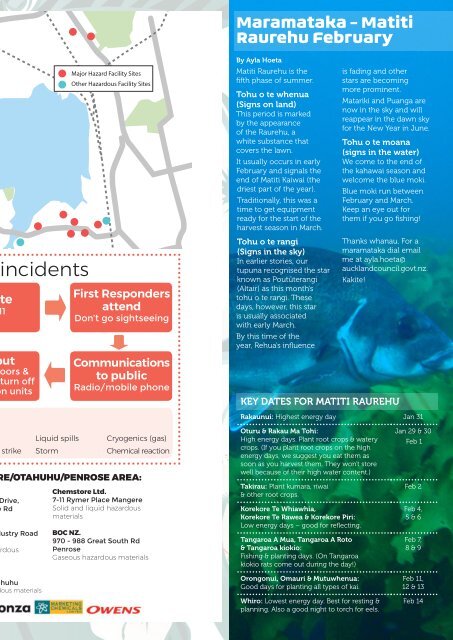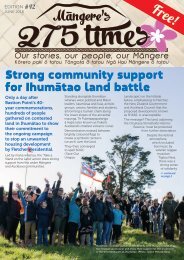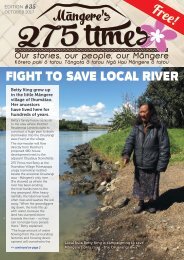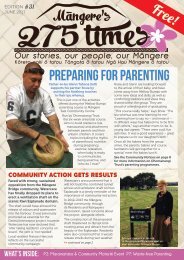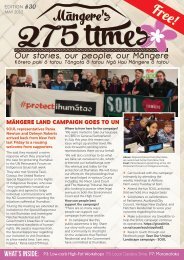275 Times February 2018
Mangere community news. This month: we welcome our new editor, look at transport priorities for Mangere and Otahuhu, report on developments at Ihumatao, farewell loved community member Bowen Wi, find out about volunteering for Talking Rubbish and more!
Mangere community news. This month: we welcome our new editor, look at transport priorities for Mangere and Otahuhu, report on developments at Ihumatao, farewell loved community member Bowen Wi, find out about volunteering for Talking Rubbish and more!
Create successful ePaper yourself
Turn your PDF publications into a flip-book with our unique Google optimized e-Paper software.
Maramataka – Matiti<br />
Raurehu <strong>February</strong><br />
Major Hazard Facility Sites<br />
Other Hazardous Facility Sites<br />
By Ayla Hoeta<br />
Matiti Raurehu is the<br />
fifth phase of summer.<br />
Tohu o te whenua<br />
(Signs on land)<br />
This period is marked<br />
by the appearance<br />
of the Raurehu, a<br />
white substance that<br />
covers the lawn.<br />
It usually occurs in early<br />
<strong>February</strong> and signals the<br />
end of Matiti Kaiwai (the<br />
driest part of the year).<br />
Traditionally, this was a<br />
time to get equipment<br />
ready for the start of the<br />
harvest season in March.<br />
is fading and other<br />
stars are becoming<br />
more prominent.<br />
Matariki and Puanga are<br />
now in the sky and will<br />
reappear in the dawn sky<br />
for the New Year in June.<br />
Tohu o te moana<br />
(signs in the water)<br />
We come to the end of<br />
the kahawai season and<br />
welcome the blue moki.<br />
Blue moki run between<br />
<strong>February</strong> and March.<br />
Keep an eye out for<br />
them if you go fishing!<br />
ncidents<br />
e<br />
1<br />
ut<br />
ors &<br />
turn off<br />
n units<br />
First Responders<br />
attend<br />
Don’t go sightseeing<br />
Communications<br />
to public<br />
Radio/mobile phone<br />
Tohu o te rangi<br />
(Signs in the sky)<br />
In earlier stories, our<br />
tupuna recognised the star<br />
known as Poutūterangi<br />
(Altair) as this month's<br />
tohu o te rangi. These<br />
days, however, this star<br />
is usually associated<br />
with early March.<br />
By this time of the<br />
year, Rehua's influence<br />
Thanks whanau. For a<br />
maramataka dial email<br />
me at ayla.hoeta@<br />
aucklandcouncil.govt.nz.<br />
Kakite!<br />
KEY DATES FOR MATITI RAUREHU<br />
Rakaunui: Highest energy day Jan 31<br />
Liquid spills<br />
Cryogenics (gas)<br />
strike Storm Chemical reaction<br />
E/OTAHUHU/PENROSE AREA:<br />
rive,<br />
Rd<br />
ustry Road<br />
rdous<br />
huhu<br />
ous materials<br />
Chemstore Ltd.<br />
7-11 Rymer Place Mangere<br />
Solid and liquid hazardous<br />
materials<br />
BOC NZ.<br />
970 - 988 Great South Rd<br />
Penrose<br />
Gaseous hazardous materials<br />
Oturu & Rakau Ma Tohi:<br />
High energy days. Plant root crops & watery<br />
crops. (If you plant root crops on the high<br />
energy days, we suggest you eat them as<br />
soon as you harvest them. They won't store<br />
well because of their high water content.)<br />
Takirau: Plant kumara, riwai<br />
& other root crops.<br />
Korekore Te Whiawhia,<br />
Korekore Te Rawea & Korekore Piri:<br />
Low energy days – good for reflecting.<br />
Tangaroa A Mua, Tangaroa A Roto<br />
& Tangaroa kiokio:<br />
Fishing & planting days. (On Tangaroa<br />
kiokio rats come out during the day!)<br />
Orongonui, Omauri & Mutuwhenua:<br />
Good days for planting all types of kai.<br />
Whiro: Lowest energy day. Best for resting &<br />
planning. Also a good night to torch for eels.<br />
Jan 29 & 30<br />
Feb 1<br />
Feb 2<br />
Feb 4,<br />
5 & 6<br />
Feb 7,<br />
8 & 9<br />
Feb 11,<br />
12 & 13<br />
Feb 14<br />
5


